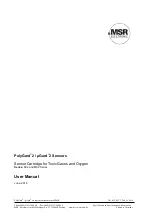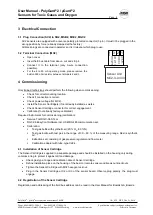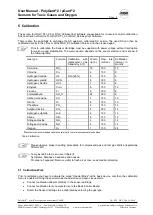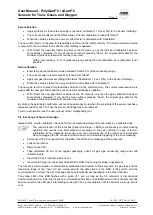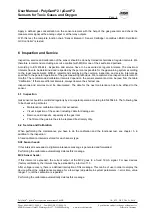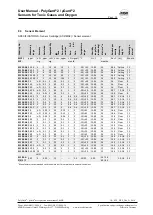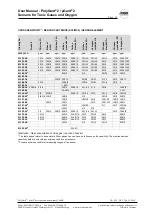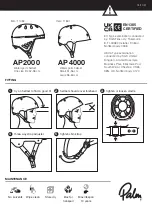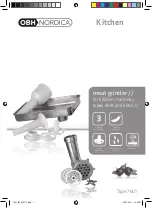
User Manual - PolyGard
®
2 / µGard
®
2
Sensors for Toxic Gases and Oxygen
Page
7
PolyGard
/ µGard
®
are registered trademarks of MSR
GA_SC2_MC2_Tox_D_0618
Phone 0049(0)8531/9004-0
Fax: 0049(0)8531/9004-54
Specification subject to change without notice
MSR-Electronic GmbH, Würdinger Str. 27, D 94060 Pocking www:msr-electronic.de
Printed in Germany
Zero calibration
Apply synthetic air (flow rate according to the table "calibration", 1 bar ± 10%) to the Sensor Cartridge.
The current zero offset and the offset value of the first calibration is read with "Read".
When the value is stable, the new zero offset factor is calculated with "Calibration".
The new offset factor is checked for plausibility and stored in the buffer memory. The current measured value
is output with the new offset factor and the offset display is updated.
With "Save" the new offset factor is written in the SC memory, only then the Zero calibration has been
successfully completed. If you exit the menu without pressing "Save", the original offset data for the
measured value calculation will continue to be used.
With a zero reading > 10% of measuring range during the zero calibration, zero calibration is not
possible.
Gain calibration
Enter test gas concentration (value between 30 and 90 % of the measuring range)
The current sensor element sensitivity is read with "Read".
Apply test gas (flow rate according to the table "Calibration", 1 bar ± 10%) to the Sensor Cartridge.
When the value is stable, the new gain factor is calculated with "Calibration".
The new gain factor is checked for plausibility and stored in the buffer memory. The current measured value is
output with the new gain factor and the sensor element sensibility is updated.
With "Save" the new gain factor is written in the SC memory, only then the gain calibration has been
successfully completed. If you exit the menu without pressing "Save", the original gain data for the
measured value calculation will continue to be used.
By limiting the gain factor, calibration will not be possible any more when the sensitivity of the sensor reaches a
residual sensitivity of 40 %. Then the Sensor Cartridge has to be replaced
For more information, see the user manual of the corresponding tool.
5.2 Exchange of Sensor Cartridge
Instead of the on-site calibration, the used SC can be replaced simply and conveniently by a calibrated one.
The communication of the local bus (Sensor Cartridge <> BSB) is continuously monitored during
operation and results in an immediate error message on the gas controller in case of fault or
interruption. When replacing the sensor unit, the communication of the local bus is interrupted
when unplugging the SC connector which leads to an immediate triggering of the error message.
Disconnect the SC connector from the BSB or the RSB (error message will be activated).
Loosen the locknut.
Remove used SC.
Take calibrated SC out of the original packaging, check for gas type, measuring range and valid
calibration date.
Insert the SC and retighten with lock nut.
Insert the SC plug into the socket at the BSB or RSB. Check plug for proper engagement.
The local bus communication is automatically established and tested. At the same time the gas type and the
measuring range of the "new" SC are compared with the data stored in the BSB. If they match and the
communication is correct, the error message will be automatically acknowledged in the Gas Controller.
The yellow LED of the BSB flashes with a pulse of 1 sec. as long as the SC connector is disconnected
(communication error). After the local bus communication has been re-established and the conformity test has
been successful, the LED goes into flashing mode with 3 sec. pulse duration
until the sensor’s warm-up time is
over.

